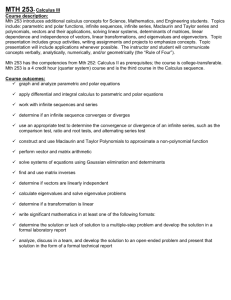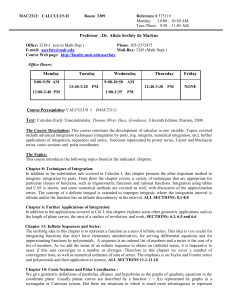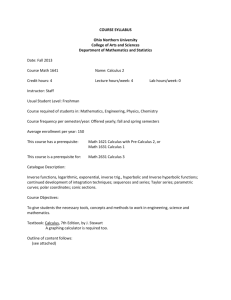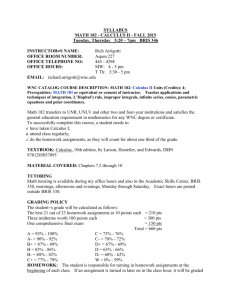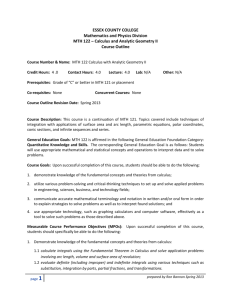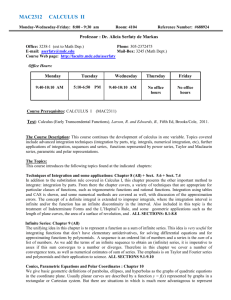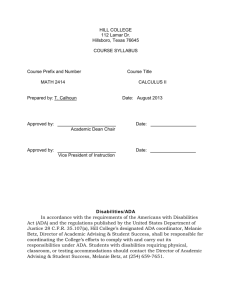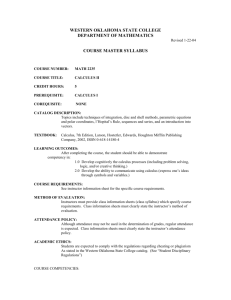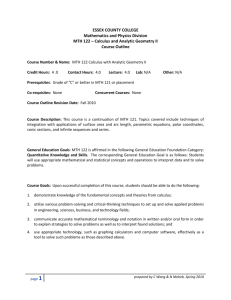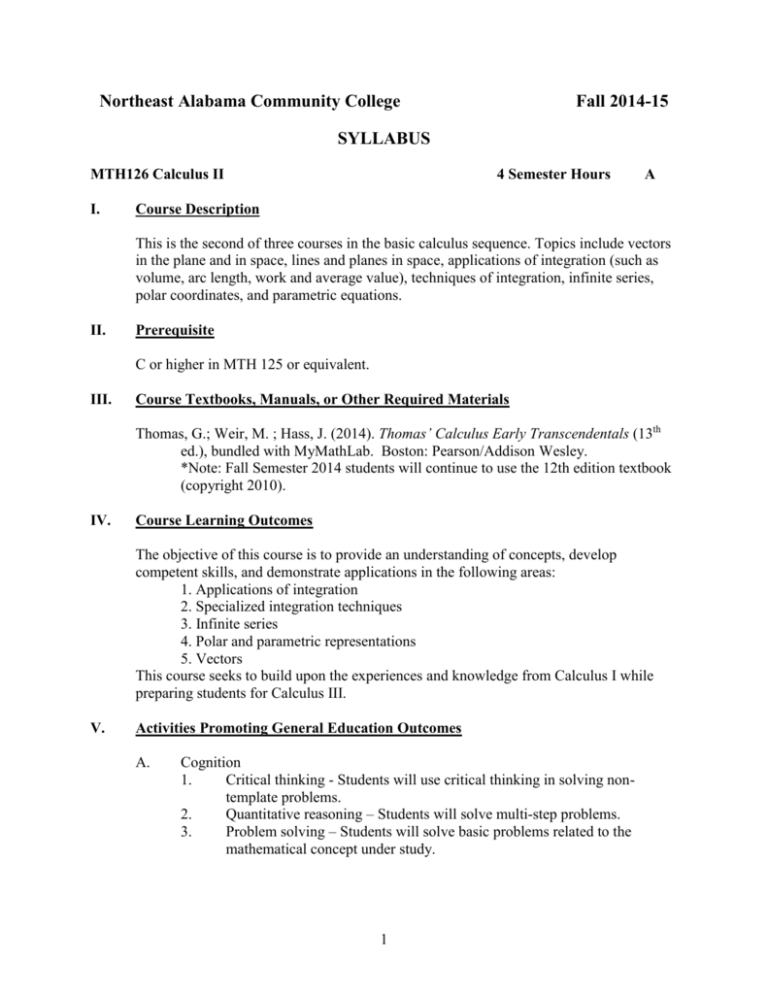
Northeast Alabama Community College
Fall 2014-15
SYLLABUS
MTH126 Calculus II
I.
4 Semester Hours
A
Course Description
This is the second of three courses in the basic calculus sequence. Topics include vectors
in the plane and in space, lines and planes in space, applications of integration (such as
volume, arc length, work and average value), techniques of integration, infinite series,
polar coordinates, and parametric equations.
II.
Prerequisite
C or higher in MTH 125 or equivalent.
III.
Course Textbooks, Manuals, or Other Required Materials
Thomas, G.; Weir, M. ; Hass, J. (2014). Thomas’ Calculus Early Transcendentals (13th
ed.), bundled with MyMathLab. Boston: Pearson/Addison Wesley.
*Note: Fall Semester 2014 students will continue to use the 12th edition textbook
(copyright 2010).
IV.
Course Learning Outcomes
The objective of this course is to provide an understanding of concepts, develop
competent skills, and demonstrate applications in the following areas:
1. Applications of integration
2. Specialized integration techniques
3. Infinite series
4. Polar and parametric representations
5. Vectors
This course seeks to build upon the experiences and knowledge from Calculus I while
preparing students for Calculus III.
V.
Activities Promoting General Education Outcomes
A.
Cognition
1.
Critical thinking - Students will use critical thinking in solving nontemplate problems.
2.
Quantitative reasoning – Students will solve multi-step problems.
3.
Problem solving – Students will solve basic problems related to the
mathematical concept under study.
1
4.
B.
VI.
Synthesis of knowledge and skills – Students will synthesize math
knowledge and skills obtained throughout the course to solve subsequent
problems in the course.
Information Literacy
Students will learn how to use a graphing calculator to describe features of
graphs, including intersection points and arc length.
Outline of Course Topics
A. This course shall include the following topics as a minimum.
1. Application of Integration
a. Area of region between two curves
b. Volumes of solids of revolution
c. Arc length
d. Work
e. Fluid pressure
2. Techniques Integration
a. Integration by parts
b. Trigonometric integrals
c. Trigonometric substitution
d. Partial fractions
3. Indeterminate forms and L’Hospital’s Rules
4. Improper integrals
5. Sequences
6. Convergence of divergence of infinite series
a. Series and convergence
b. The integral test and p-series
c. Comparisons of series
d. Alternating series
e. The ratio and root tests
7. Power series
8. Taylor, Maclaurin series and Binomial series
9. Parametric equations
10. Polar coordinates and polar graphs
11. Area and arc length in polar coordinates
12. Vectors in the plane and space
13. Operations with vectors
14. Lines and planes in space
B. Optional topics may include the following.
1. Moments, center of mass, and centroids
2. Conics
VII. Methods of Instruction
2
A.
B.
C.
D.
E.
Lectures
Class discussion
Computer/Internet tutorials
Video tutorials
Individual instruction (instructor and tutors)
VIII. Evaluation and Assessment
A.
The course grade will be determined by the following methods:
1.
2.
3.
4.
5.
6.
7.
8.
Written and oral quizzes
Written exams
Oral presentations (individual and/or group)
Homework
Class participation
Projects
Computer activities
Comprehensive final exam
The individual instructor and/or department will determine grades based upon the
following: A=90–100%, B=80–89%, C=70–79%, D=60–69%, and F=below 60%.
B. Departmental Assessment of General Education Outcomes
1. Critical thinking skills, quantitative reasoning, problem solving, and synthesis
of knowledge and skills will be evaluated by an activity requiring the
application of integration techniques. Students will demonstrate attainment of
the general education outcome of cognition with at least 70% proficiency.
2. Information literacy, with a technological application, will be assessed
through the students’ graphical interpretation of various types of graphs using
the graphing technology taught in the course. Students will demonstrate
attainment of the general education outcome of information literacy with at
least 70% proficiency.
C. Use of Assessment Findings
During the Fall In-service of the year following the scheduled review of MTH 126, a
committee will review all course assessment materials submitted by the instructors and
division chair. The committee will submit a report of any recommended curriculum
changes for MTH 126 to the division chair, who will then submit them to the Student
Learning Outcomes Committee. Upon approval by the Student Learning Outcomes
Committee, a copy will be filed with the Office of Institutional Planning and Assessment.
IX.
Attendance
Students are expected to attend all classes for which they are registered. Students who are
unable to attend class regularly, regardless of the reason or circumstance, should
3
withdraw from that class before poor attendance interferes with the student’s ability to
achieve the objectives required in the course. Withdrawal from class can affect eligibility
for federal financial aid.
X.
Statement on Discrimination/Harassment
NACC and the Alabama State Board of Education are committed to providing both
employment and educational environments free of harassment or discrimination related to
an individual’s race, color, gender, religion, national origin, age, or disability. Such
harassment is a violation of State Board of Education policy. Any practice or behavior
that constitutes harassment or discrimination will not be tolerated.
XI.
Statement of Adherence to ADA Guidelines
Instructors will adhere to the Americans With Disabilities Act and/or Section 504 of the
Rehabilitation Act (1973) and will publish the following statement on course outlines
given to students at the beginning of each semester: “Any individual who qualifies for
reasonable accommodations under the American With Disabilities Act or Section 504 of
the Rehabilitation Act (1973) should notify the instructor immediately.”
4

